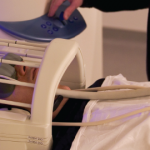New research shows that patients with fibromyalgia have hypersensitivity to non-painful events based on images of the patients’ brains, which show reduced activation in primary sensory regions and increased activation in sensory integration areas. Findings published in Arthritis & Rheumatology, a journal of the American College of Rheumatology (ACR), suggest that brain abnormalities in response to non-painful sensory stimulation may cause the increased unpleasantness that patients experience in response to daily visual, auditory and tactile stimulation.
Fibromyalgia is a chronic, musculoskeletal syndrome characterized by widespread pain, affecting roughly two percent of the world population, say experts. According to the ACR, five million people in the U.S. have fibromyalgia, which is more prevalent among women. In previous studies fibromyalgia patients report reduced tolerance to normal sensory (auditory, visual, olfactory, and tactile) stimulation in addition to greater sensitivity to pain.
For the present study, researchers used functional magnetic resonance imaging (fMRI) to assess brain response to sensory stimulation in 35 women with fibromyalgia and 25 healthy, age-matched controls. Patients had an average disease duration of 7 years and a mean age of 47.
According to the study, patients reported increased unpleasantness in response to multisensory stimulation in daily life activities. Furthermore, fMRI displayed reduced activation of both the primary and secondary visual and auditory areas of the brain, and increased activation in sensory integration regions. These brain abnormalities mediated the increased unpleasantness to visual, auditory and tactile stimulation that patients reported to experience in daily life.
Lead study author, Dr. Marina López-Solà from the Institute of Cognitive Science, University of Colorado Boulder said, “Our study provides new evidence that fibromyalgia patients display altered central processing in response to multisensory stimulation, which are linked to core fibromyalgia symptoms and may be part of the disease pathology. The finding of reduced cortical activation in the visual and auditory brain areas that were associated with patient pain complaints may offer novel targets for neurostimulation treatments in fibromyalgia patients.” (posted 9/16/2014)
Full citation: “Altered Fmri Responses to Non-Painful Sensory Stimulation in Fibromyalgia Patients.” Marina López-Solà, Jesus Pujol, Tor D. Wager, Alba Garcia-Fontanals, Laura Blanco-Hinojo, Susana Garcia-Blanco, Violant Poca-Dias, Ben J. Harrison, Oren Contreras-Rodríguez, Jordi Monfort, Ferran Garcia-Fructuoso and Joan Deus. Arthritis & Rheumatology; Published Online: September 15, 2014 (DOI: 10.1002/art.38781).
Publication link: http://doi.wiley.com/10.1002/art.38781
